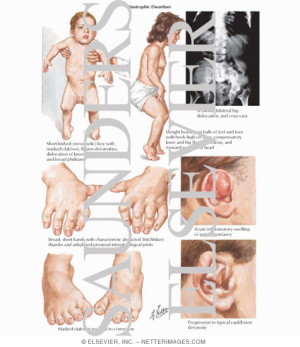Treating Kids With Dwarfism: Best and Worst Treatments
by
Lynn Shapiro, Writer | April 02, 2009

Dwarfism
According to a literature review published in the April issue of the Journal of the American Academy of Orthopaedic Surgeons (JAAOS), treating patients with dwarfism is an extremely complex process. Many treatments that are currently tried should be avoided while other measures are highly recommended, the authors say.
Treatments to be Avoided
Limb lengthening treatments for those living with achondroplasia have met with mixed results. "Not only is limb lengthening a huge time commitment for the families involved, but children with achondroplasia are taken out of the environment where they play, interact and have fun to be placed in treatment for several years," said study co-author Michael C. Ain, M.D., associate professor, Department of Orthopaedic Surgery and Neurosurgery, Johns Hopkins Hospital, Baltimore, MA.
"At the end of the day, these kids may be able to reach a higher shelf, but their level of physical activity in both athletic and sporting events may be very limited or not existent at all," he says.
Some studies have found that height can be gained with growth hormone injections, but the authors question whether the minimal average height increase is worth undergoing five years of daily injection. What's more, these hormone injections may cause or accelerate symptoms of spinal stenosis. Surgical treatments can produce greater increases in height, but also carry a much higher risk of complications, the authors say.
CT Scans or MRI Find Stenosis of the Foramen Magnum
Rather than use any of these treatments, the authors found that early diagnosis and treatment of the manifestations of achondroplasia, sometimes even before they become symptomatic, may produce better outcomes for patients later in life.
For example, some patients with achondroplasia have stenosis of the foramen magnum, a condition in which the hole in the base of the skull that allows the spinal cord to be connected to the brain is too small. This condition compresses the brain and cord, causing developmental delays and may even be fatal. Symptoms of stenosis of the foramen magnum usually occur in the first two years of life, but may not appear until later, when developmental delays become apparent.
Therefore, the American Academy of Pediatrics recommends that all infants with achondroplasia be screened via CT scan or MRI, so that this condition can be treated surgically before it causes further medical problems.
"With so many medical specialties involved, each needs to be aware of all of the symptoms of achondroplasia," says study co-author Eric D. Shirley, M.D, lieutenant commander, Medical Corps, United States Navy, and attending pediatric orthopaedic surgeon, Naval Medical Center Portsmouth, Portsmouth, VA. "Many of these conditions are interrelated."
